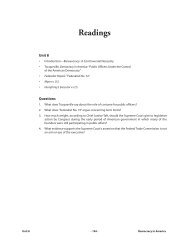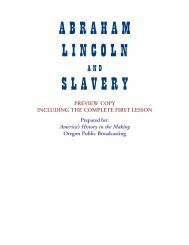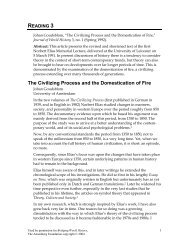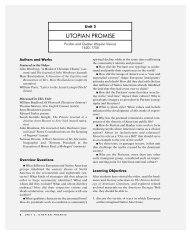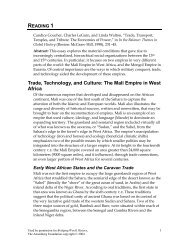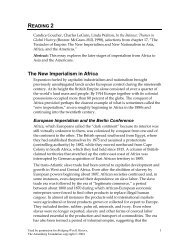Create successful ePaper yourself
Turn your PDF publications into a flip-book with our unique Google optimized e-Paper software.
policies in India should be seen as part of a “world crisis” between 1780 and<br />
1820 in which “the population of large parts of the world… was faced with a<br />
sharp realignment of trade… at the very time that the demands of the state<br />
through taxation and extraordinary requisitions was at its height” (1989, 187).<br />
As part of this reorganization, the British facilitated Indian exports of grains<br />
and other agricultural produce like opium and cotton. British agency houses<br />
working in conjunction with local merchant groups also dampened the<br />
demand for indigenous textiles when they moved British machine-made goods<br />
further and further along local trade networks in the 1820s.<br />
British political relations with Kashmir reflected these imperial goals. Even<br />
when Kashmiri shawls were considered high fashion in Europe, British Indian<br />
officials declined the opportunity to control the home of Kashmiri shawl<br />
production. In 1846, the colonial government’s troops defeated Maharaja Ranjit<br />
Singh’s successors in the northwest, [End Page 49] but, instead of annexing<br />
Kashmir outright, the British apportioned it to a local ruler, Gulab Singh of<br />
Jammu, in return for a token annual tribute of shawls and shawl fleece-bearing<br />
animals. The Governor-General of India, Lord Hardinge, did attempt to amend<br />
an 1842 treaty between China and the Sikhs which had stipulated that Kashmir<br />
would continue to have a monopoly on the trade in Tibetan and Ladakhi shawl<br />
wool. Hardinge wanted to abrogate this trade agreement to make it easier for<br />
the rival Kashmiri-type shawl production centers in British India to obtain the<br />
raw material for shawls, but he was unsuccessful. In any case, the British home<br />
government was focused on the promotion of British textiles in competition<br />
with all Subcontinental ones. Queen Victoria was rumored to give the Kashmiri<br />
shawls she received annually as tribute to her ladies-in-waiting and she<br />
appeared publicly in Paisley-made shawls (Blair 1904, 26; Irwin 1973, 24; Datta,<br />
25). The British purchased some Kashmiri shawls for diplomatic gifts, but they<br />
never replaced the patronage extended to Kashmiri weavers by indigenous<br />
rulers. 28 Maharaja Ranjit Singh made use of Kashmiri handloomed shawls as<br />
enthusiastically as had the Mughals in former centuries, but British officials<br />
patronized British manufacturers instead, both as a matter of colonial policy<br />
and because of their Eurocentric tastes (Siddiqi 1995, 52, 54; Bayly 1992, 279-80).<br />
At least as important for the Asian trade in Kashmiri shawls were the<br />
problems on the supply side. Epidemics, famines (famously in 1834), and<br />
internal political problems caused Kashmiri weavers to migrate south to<br />
Punjab, where they found it more difficult to obtain their raw materials. The<br />
supply of shawl wool to Kashmir itself became constricted due to its<br />
diversion to the British-protected Kashmiri-type [End Page 50] shawl<br />
production centers in the Punjab hills near Jammu and in Punjabi cities on the<br />
plains. Shawl imports into the British territories drastically declined in the<br />
mid-1830s “and in 1836, the Hardwar Fair, which was essentially a great<br />
shawl market, failed for the first time on record” (Bayly 1992, 279–80).<br />
Used by permission for Bridging World History, 18<br />
The Annenberg Foundation copyright © 2004



